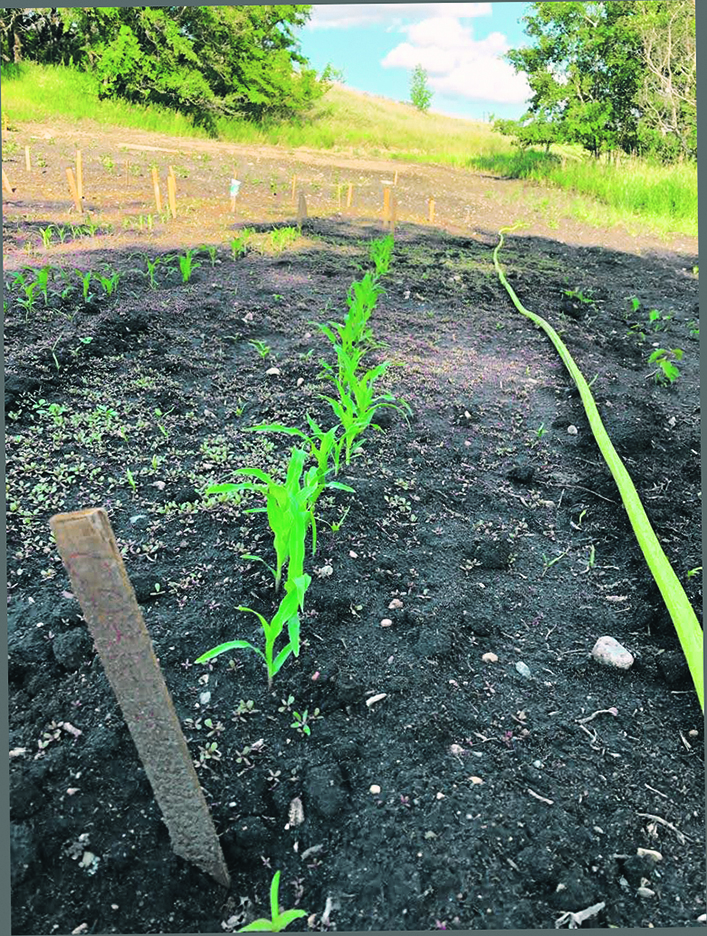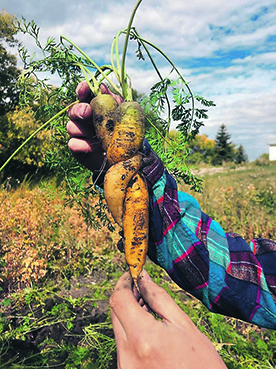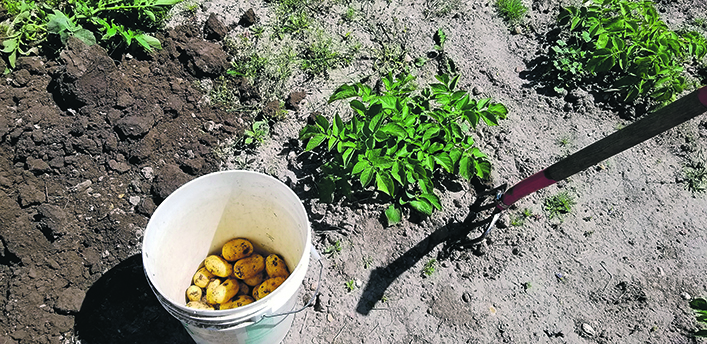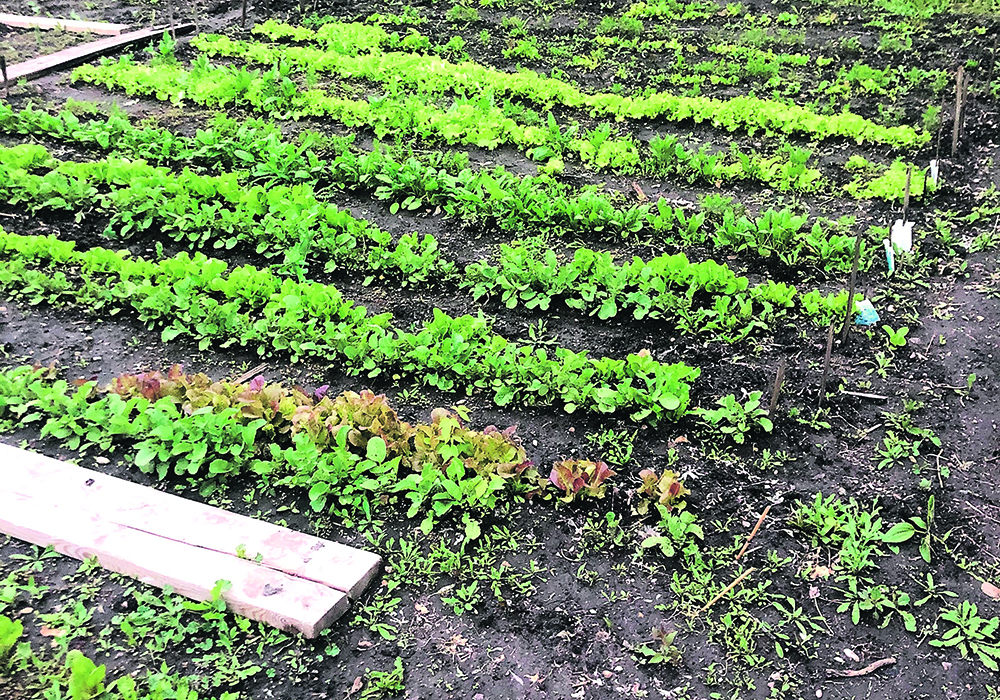Sheri Hathaway had been gardening since she was six, so the opportunity to get her hands dirty again couldn’t be passed up
From the time I was about six years old, I’ve been gardening. I liked to follow my mother down her rows of vegetables, asking questions as usual. She gave me a job pulling weeds, showing me first what constituted a weed and what precious vegetable I must leave to grow.
“You can help me with your strong little fingers,” she said (the first rule in motivating a child to work — tell them they’re capable). “You know what a dandelion looks like (I had picked many bouquets to happily give her) so wherever you see them, pull them out, if you can (another rule in motivating a child to work—tell them it’s OK if they can’t). See these ones with leaves almost like a dandelion? That’s sow thistle, so pull those out, too.”
Now on a mission, I set to work, not realizing my mother had not only gained a helper but also, a silent one. Dad used to say, “how can a little girl ask so many questions?” Mom gave me a job.

Her garden never reached the pristine, beautiful condition of those pictured in Better Homes and Gardens. Her goal was pragmatic — healthy produce from garden to table, not a picture-perfect showpiece. No one stood out there admiring my mother’s garden, but it regularly birthed large and hearty food for a growing family, and most importantly, at little cost. Her garden on the farm covered half an acre and it was her pride and joy.
I think it was that same year when she gave me a postage-stamp-sized piece of dirt for my very own garden. She helped me stake out three or four short rows and gave me some seeds. I had already “helped” her plant her garden, so once my rows were staked with pieces of baler twine, I knew what to do. She then returned to her own work, having once again achieved some quiet time for herself, but at a cost — I no longer wanted to weed her garden because I was much too busy with my own. Come to think of it, maybe her motivation for giving me my garden was to reduce my help in weeding hers. Dare I say my parents actually were smarter than I?
Read Also

Know what costs are involved in keeping crops in the bin
When you’re looking at full bins and rising calf prices, the human reflex is to hold on and hope for more. That’s not a plan. It’s a bet. Storage has a price tag.
People have gardened since the beginning of time, primarily to produce healthy food. Only in recent times has someone voiced other benefits like therapy for the soul, character-building, and family bonding.
There is something thrilling about poking lifeless, hard seeds in the ground, sprinkling on water, and watching delicate life spring out of the dirt.
After a summer of building self-discipline to weed it whether you felt like it or not (a good chance to work out your frustrations over the other parts of life), you get the huge satisfaction of bringing in your produce and yes, actually eating it. Fresh from your own backyard, the flavour pops in your mouth at the first bite, all the more delicious after you’ve sweated over it all summer.
Gardens were a part of everyday life for anyone with a patch of ground until we fell in love with technology and industry accompanied by the idea of a life of leisure, and gardens disappeared from many farms and city plots. In recent decades though, our awareness of unsafe food and soaring prices has made us think again of sticking a few seeds in the dirt and watching them grow. In the past two years, gardening has exploded all over the world because people at home all day needed something to do, along with concern over the price increase and uncertain transport.
For my mother, gardening season began in late winter with the arrival of seed catalogues and she pored over them at the living room table with pen and paper, making lists and adding totals until her order was settled and mailed, her eyes bedazzled by the beautiful photos of lush, boisterous plants.

Today, we still have seed catalogues, but now seed racks sprout up every spring almost anywhere with the regularity of the heads of gophers from their holes. Every seed farm has its website, too.
Other creative ways of obtaining seeds are seed exchanges (the seeds are free) through some local libraries or a Seedy Saturday sponsored by either a farmers market or community group. Personally, I think sharing seeds with friends and neighbours is the most satisfying way to grow friendships as well as gardens. One year, I got a small package of poppy seeds inside an Easter card, a lovely surprise.
Gardening teaches us about life. The first attempt isn’t always successful, and in most cases, often a disappointment.
When my daughter and her husband bought an acreage, the whole family got excited about a big family garden, offering to help in the work and share in the harvest. Missing my farm garden, this idea offered more interest than my garden box in the city. My city garden plot didn’t reward me with the big harvest I got on the farm due to trees giving shade and the tree roots siphoning up most of the water so I turned to garden boxes as an alternative.
They have their limitations but I still enjoy working in them and eating the delicious harvest, even if it’s small.

Working together on a project creates stronger relationships. My daughter planned the layout. We all bought seeds, hunted down tools and planned family workdays. The previous owners on this land had neglected the garden for years and our work was tough going at first.
We slogged through tilling the rock-hard dirt while trying to save the baby plants from dying of drought and pulling out the biggest weeds. Thankfully, it rained occasionally that year. On family weeding days, we tried to lighten the work by having contests to see who could pull the longest string of quack grass or the fattest dandelion root.
In the fall, we hurried out, excited to see what our labours produced, only to look down, dejected at the resulting meagre piles of forlorn little vegetables. We did manage some big, bold radishes in spring and a good crop of lettuce over the summer, but in fall, only some so-so carrots and a few small potatoes rewarded our efforts.
“It’ll be better next year,” I said, drawing on wisdom from my father and every other farmer the world over for centuries. We evaluated and made plans for the following year. We knew we’d made mistakes. Gardening is a learning process.
The next year, things improved. Every year, the condition of the soil upgraded. The biggest weeds gave up the fight a little more than the previous year, and the fall harvest was bigger and more plentiful. Ah, how a sweet success encourages the hopeful.
The third year produced a real harvest — big potatoes rolled out of the dirt, fat carrots rose up in answer to the pull of our hands, long beans called us to go picking every third day for two months. We gave vegetables away. We canned. We froze. We smiled. This was more like it.
Then, last year, we had a drought. We learned that even when things don’t go well, there are still some vegetables that will grow in our garden, mostly corn, beans and potatoes. That’s why it’s good to plant a variety of different plants. The deer liked the peas. We talked over the year and adjusted our plans. This summer, we’re trying a new variety of beans. Now that the basics are getting underway, we’re getting bold, venturing out. Experimenting.

It takes perseverance, a plan and hard work to garden, but that’s what anyone needs for success in any part of life. Gardening teaches that. Each fall, we’ll look at the successes and failures and modify our plans for next year. Every year we learn something about the land and our own capabilities. We discover what we can grow and the particular varieties we like to eat.
If you’re starting out in your gardening journey, the best advice I can give you is don’t start too big. Be realistic about how much ground you can till and how much weeding you’ll want to do in summer. Also, plant what you like to eat and learn how to grow it. Seeds are small — know how big the vegetable will become and don’t be too liberal in sprinkling them in ground.
Weed in the mornings if you can, before it gets hot and fewer mosquitoes are out. Water at night when it’s cool so you don’t lose most of your water to evaporation.
If your children show interest, encourage them with small jobs, maybe their own garden, and don’t explode if they pull up the odd young vegetable. They’re learning too. Enjoy yourself. Make it fun. Marvel at nature. Let your soul heal.
And yes, ask questions. Always ask questions.
Those without a patch of ground who still want to garden can access nearby community garden plots or ask a neighbour to share the harvest with them.
Contact your town’s office.
In Saskatoon, the city rents allotment gardens (bigger than the usual community garden plot) and Child Hunger and Education Program (CHEP) assists interested groups in operating community gardens. Go to chep.org/community-gardens.
There are innovative ways of obtaining fresh food without gardening, too. Flashfood.com offers a free app that you set for your location and it notifies you of all types of food from participating grocery stores that has expired but is still good for eating. Prices vary from 50 percent off to $5.
In Saskatoon, CHEP operates a Good Food Box program with the help of volunteers and provides fresh produce year-round while partnering with local producers.
At least 10 days before delivery day, customers place their order and choose the most convenient co-ordinator location for pickup.
On delivery day, the co-ordinator tells the customer the orders have arrived and arranges a time to drop by and pick it up. See chep.org/good-food-box/.
CHEP’s food access co-ordinator, Cory Lang, said rural dwellers can access the program. As well, rural depot co-ordinators can pick up boxes from Station 20 West in Saskatoon and take them out to their location.
In Calgary, a similar Good Food Box program is operated by Community Kitchens. See ckpcalgary.ca/goodfoodbox.















